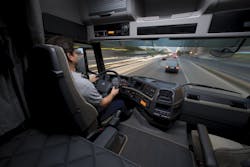Volvo European study finds driver fatigue and inattentiveness cause of most truck accidents
Nine out of 10 accidents involving trucks are a result of the human factor, according to a recent report on traffic safety and road accidents in Europe produced by the Accident Research Team at Volvo Trucks.
The report is based on Volvo’s own investigations of accidents as well as data obtained from various national and European authorities and describes why accidents with trucks occur, their sequence and what can be done to reduce the risk of accidents and their consequences.
“Ninety percent of all truck accidents stem entirely or partly from the human factor, for instance when one or more of the drivers of the involved vehicles are distracted or misjudge their speed,” said Carl Johan Almqvist, traffic and product safety director at Volvo Trucks.
Heavy trucks are involved in 17% of all fatal accidents and 7% of accidents resulting in personal injuries. The majority of accidents resulting in truck driver injuries are single-vehicle incidents in which the truck drives off the road. More than half of all serious accidents with trucks consist of collisions between cars and trucks.
The report also reveals that drinking and driving is not one of the major causes of road accidents involving truck drivers. Only 0.5% of truck drivers involved in serious accidents were under the influence of alcohol. The corresponding figure for accidents involving passenger cars varies between 15% and 20%.
Thanks to safer vehicles, improved infrastructure and safer behavior on the road, the number of fatal accidents on European roads has dropped continuously since the early 1990s. But far more lives would be able to be saved if more people used their seat belts, something that not even half of the truck drivers on European roads do, Almqvist said. Only 5% of the truck drivers who died in road accidents were wearing seat belts.
“As long as people are injured in road accidents, we will continue to pursue higher safety levels. Firstly by making our trucks safer for drivers and other road users, and secondly by spreading knowhow and by impacting patterns of behavior and persuading more people to use the seat belt,” Almqvist added.
He points to how Volvo Trucks’ new active safety system Collision Warning with Emergency Brake can avoid a rear end collision. To view a video of the system in action, go to http://www.youtube.com/watch?v=ridS396W2BY.
“Access to facts about accidents is immensely valuable for our ongoing safety work, helping us make the right priorities in our product development. For instance, we have further enhanced safety levels in our latest truck models with a range of support systems that improve visibility, alert the driver or focus the driver’s attention if something is not right,” Almqvist concluded.
Volvo Trucks’ Accident Research Team (ART) has investigated and analyzed traffic accidents involving trucks since 1969. Publication of the “European Accident Research and Safety Report 2013” marks the first time Volvo's accident research has been published externally.
